MSC Cruises
MSC and the MSC Group
Almost a fairytale in shipping history, MSC was founded by Captain Gianluigi Aponte in 1970 with a single trampship for breakbulk cargo, the MSC Patricia. Although his family originated from Sorrento, Italy, the company was officially founded in Brussels, Belgium. The normal route for the MSC Patricia was from several African ports to Sorrento, Aponte's hometown. Throughout the 1970's, the company expanded by buying secondhand freightvessels and their network expanded too, sailing in Europe, Africa and the Indian Ocean at the end of the same decade. Expansion didn't stop there, as the company started the eighties with sailings between Europe and north America as well as Australia, now spanning the globe. Stilkl, the company relied on secondhand tonnage, asd late as 1994 they had the first ship constructed themselves, named the MSC Alexa. Meanwhile, the company also had bought itself into the cruisemarket by aquiring the financial questionable Lauro Lines, another Italian company. That story comes later down the page. MSC Group nowadays is still owned by the Aponte family, making it the largest privatly-owned shippingcompany in the world and the second largest shippingcompany in the world, just after APM-Maersk. As it is still owned by one family, the company is not registered to any stock-exchange and not obligated to publish it's results because of that. Next to the MSC containerfleet and the cruisefleet, MSC also ownes a controlling stake in the ferrycompanies SNAV and Grandi Navi Veloci (GNV), both sailing in the Mediterranean. They also own a logistics company under the name of MEDLOG and a Terminal Division named Terminal Investment Ltd.
Lauro Lines
MSC Cruises is the continuation of a much older company. This company was founded in 1912 as Lauro Lines by an Italian named Achille Lauro in Napels. Initially, the company concentrated on freight untill the outbreak of the second worldwar. When this war ended, they entered the emigranttrade between the Mediterranean and Australia when three freightships, Ravella, Olimpia and Napoli were rebuilt for passengerservices. In 1949, the company bought its first real passengership from the American company Grace Line and renamed her the Surriento. Achille Lauro, the founder of the company was nicknamed 'The King Of Napels' due to his growing fleet, making him a multi-millionaire.
Achille Lauro not only was a great shipping magnate, he also was mayor of Napels between 1952 and 1958 and again between 1960 and 1961. In the late 1930's, he also was president of the Napels football club SSC Napoli.
In 1964, he bought two former Dutch oceanliners, Willem Ruys from Koninklijke Rotterdamsche Lloyd and Oranje from the Nederland Lijn. He named Willem Ruys after himself, Achille Lauro, and Oranje got the name of his wife, Angelina Lauro. The ships were modernized and rebuilt totally, although they did not loose their handsome oceanliner looks. There was one major incident, when Angelina Lauro was rebuilt a big fire broke out and six people were killed.
The ships ran an immigrant serice between Europe and Australia, not unfamiliar for these ships who sailed this route also mostly in their Dutch years, being built for the route between Holland and the Dutch Indies (now Indonesia). Their most normal route was from Bremerhaven and Southampton to Sydney and Wellington via Suez. When the Suezcanal was closed, the ships sailed via Capetown. In 1970, the mail contract was lost by Lauro to the Chandris Line, the later Celebrity Cruises. The profits declined sharply and Lauro had the ships placed in full-time cruise service. This went without too much problems throughout the 1970's, but in 1979 the Angelina Lauro caught fire at St.-Thomas and to get the flames out so much water was poured into the ship that she sank at her berth. She was sold for scrap, although she never reached her final destination because she sank in the mid-Pacific on route to Taiwan.
Willem Ruys, the largest liner ever for Rotterdam Lloyd, became Achille Lauro in 1964. In 1987, MSC took over and the company became what it is today. The picture postcard is from my private collection. Achille Lauro burned and sank close to South Africa in 1994 and quickly, the Lauro name was dropped and replaced by the MSC name from 1997 onwards.
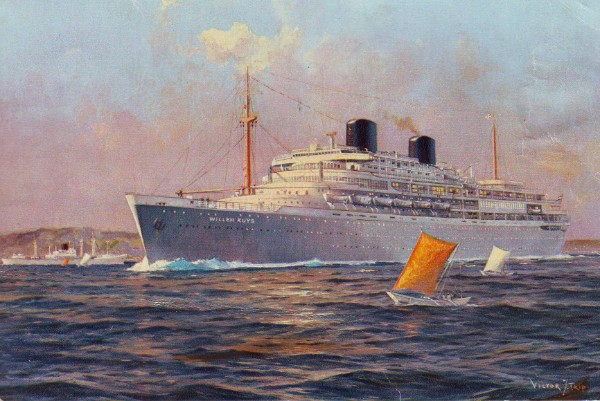
Just sailing with one ship now, the 1980's began for Lauro Lines. But the problems were far from over. In 1985, terrorists from the Palestine Liberation Front hijacked the Achille Lauro when she sailed on a cruise between Alexandria and Port Said. One American passenger was murdered and because of this the diplomatic relations between the USA, Egypt and Tunesia became very edgy. Finally, also the Italian government resigned because of the incident. All this was not good for the passengernumbers of the Achille Lauro, of course. In 1987 the company was bought by the Mediterranean Shipping Company and renamed StarLauro Cruises.
The MSC take-over and a bright future
MSC added a second ship to the fleet in 1990, when Monterey was bought from Aloha Pacific Cruises. This was an old ship, built in 1952 as Free State Mariner for the US Maritime Commission. In 1994, another disaster happened to the company when Achille Lauro caught fire while on a cruise between Genoa and Capetown. A rescue-operation was carried out, but for two passengers this came too late. The ship sank a few days later.
As a replacement, MSC added the also aging Enrico Costa from Costa Cruises and renamed her Symphony. It was the first time a ship for MSC was named in the music-theme. This was to become the most used theme in early MSC cruiseshipnames. The ship was built in 1950 as the French liner Provence of the SGTM. In 1995, the cruiseships started sailing under the name of their mothercompany Mediterranean Shipping Company. This later changed again to MSC Cruises. Also in 1995, Rhapsody was bought from Cunard, where she sailed as their Cunard Princess. This ship was built in 1974 so somewhat more modern then her fleetmates. She is shown on the picture below, docked in the Vissershaven at IJmuiden in 2005.
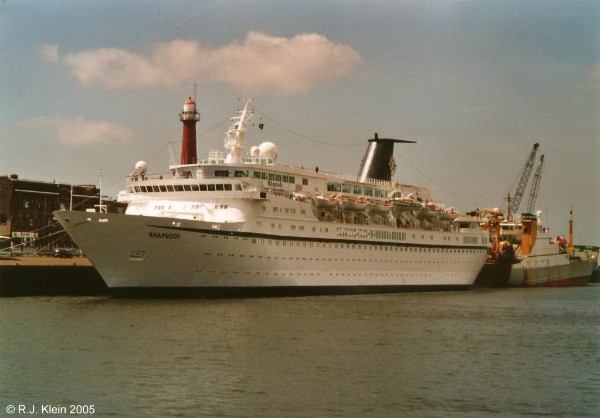
The name MSC did not have anything to do with all problems of Lauro before so the company became a totally new one in general. With the backing of the great Mediterranean Shipping Company, that had became one of the biggest shippinglines in the world, the cruisecompany grew rapidly. So when the company was looking for larger and modern ships to add for replacing the older ships at the beginning of the new millennium, the bankrupcy of Festival Cruises came at the right moment for MSC. Festival Cruises was declared bankrupt in january of 2004 and MSC was eager to take over the newest ships of that company. They aquired the European Dream and the European Vision and renamed them MSC Sinfonia and MSC Armonia. Another pair of near sisters was built by MSC in the same period and they were MSC Lirica and MSC Opera. So in just two years four new and very modern ships were added to the fleet. But this was just the beginning of a huge building program like the industry doesn't see very often.
Below is one of the first new generation of megaships of MSC, the MSC Armonia at IJmuiden in 2008, a ship that came over from the defunct Festival Cruises in 2004.
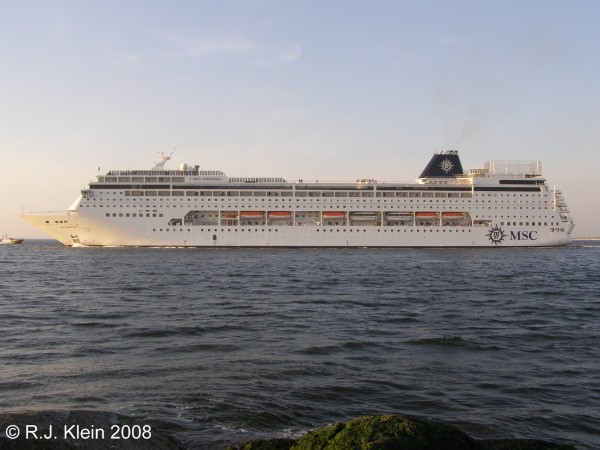
After these aquisitions MSC started a big expansion of the fleet, not only in ships but also in size. The Musica class was built, a class of 90.000-tonners named MSC Musica (2006), MSC Orchestra (2007), MSC Poesia (2008) and MSC Magnifica (2010). Also, another class was built, the Fantasia-class of over 133.000 tons. These are the biggest cruiseships of any European cruiseline ever built. It consists out of the MSC Fantasia (2008), MSC Splendida of 2009, MSC Divina (2012) and MSC Preziosa (2013). MSC is now sailing with one of the youngest fleets in the world, after the older ships were transferred or sold to other companies.
Below, one of the Musica-class ships, the MSC Magnifica, is shown leaving IJmuiden at the 21st of april 2013.
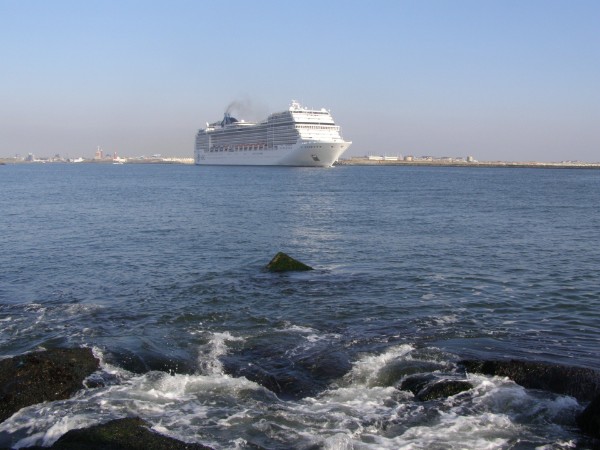
MSC in The Netherlands
Holland became a very important hub for the Northern European cruises of MSC, that were offered when more ships could be used. Amsterdam is one of the most important cruiseports in this part of the continent, but they have a slight problem because the city is situated around 25 kilometers inland. This is due to the fact that when Amsterdam had its golden age in the 17th century, the city was situated on an inlet of the inland sea Zuiderzee. With all Dutch water engineering works to stop the country from flooding, the inland sea was dammed off and Amsterdam was instead given access to the Northsea directly via the Northsea Canal. This was a very good connection, but in modern times, time is money and it costs ships around three extra hours to pass the locks at IJmuiden and then sail on to Amsterdam. Of course, they also have to get back to sea so another three hours are 'wasted'. MSC really wanted to use Amsterdam as a main hub, but this extra lost time was a big problem for them. In recent years, the port of IJmuiden, that is part of the Amsterdam Harbour Company too, is filling in the gap and a terminal was constructed in the first years of the new millennium. But the space here is rather small, so when a new dock was built on the former beach, it was decided to dock larger cruiseships here. Only problem was, there was no terminal. Talks between the Port Of Amsterdam and MSC resulted in MSC promising a large amount of sailings from The Netherlands, when a new terminal was built in the new dock of IJmuiden. Within six months during the winter of 2011/2012, the terminal was built to the specifications MSC gave. Nothing more, nothing less. During 2012, MSC ships docked around 35 times at the new terminal, sailing cruises within Northern Europe and down to Spain from here. The terminal is also used for other companies, Saga Holidays, Holland America Line and Pullmantur Cruises for example.
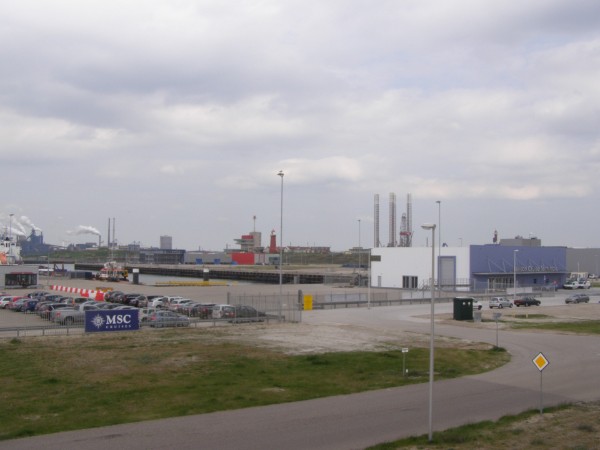
The new dock and terminal at IJmuiden used by the MSC ships is shown above, without a ship this time but with the MSC flag because of the connection between MSC and the terminal. Underneath is the sign of the MSC for Unicef project, in which MSC Cruises donates one euro per passenger to several projects of this worldwide organisation. In the first years, the children of the favelas in Rio de Janeiro and Sao Paolo in Brazil were the main objective, but in 2014 this changed to projects in Africa. Over the last two years, more then 2 million euro's were collected from passengers and crew.
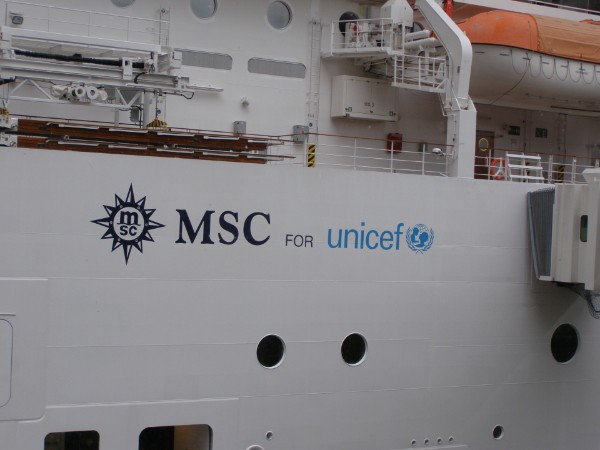
More growth and expansion of the fleet
MSC is truly a very large operator nowadays, achieved in just over a decade. They are now soon to become the thirth largest cruiseline in the world, after Carnival and Royal Caribbean of course. Even the ships are getting larger themselves. Throughout 2014 and 2015, the four ships of the Lirica-class were lenghtened and updated. Next to this so-called 'Renaissance' lenghtening project, in march of 2014 the announcement also came that MSC ordered at least two 167.000-ton cruiseliners from the STX France wharf at St.-Nazaire. Also an option for two more ships of this class was signed. This class of ships is the thirth largest class ever ordered, after Royal Caribbean's Oasis-class and Quantum-class. Just a few months later, MSC also announced an order placed with Fincantieri for the building of three 154.000-ton cruiseliners, that will have a totally revolutionairy design. They will be based on Fincantieri's Milla-project and recieve a midships funnel, a wide promenadedeck free of lifeboats and a superstructure that will be smaller to the aft and bow of the ship. The ships promenade will be a little like the boardwalk that was introduced by Norwegian Cruise Line on the Norwegian Breakaway-class, and give access to restaurants and shops along the way. Then, in april of 2016 and even before any of those seven newly ordered ships entered service, MSC again made a jawdropping announcement when they signed a letter of intent with the STX France yards at Saint-Nazaire for four more cruiseliners, this time they stated that these LNG-powered ships will be well over 200.000 tons and come close to the Oasis Of The Seas and her sisters. With now eleven ships in the pipeline, it was the first time ever that a single company has this many orders placed for introduction in just one decade and MSC will at least more then double their capacity in just three years time between 2017 and 2020. At the end of 2017, the company had another industries first as at the same time four ships were under construction. MSC Seaside and MSC Seaview at Fincantieri and MSC Bellissima and MSC Grandiosa at STX France.
MSC Magnifica leaving Lison, Portugal at the 13th of october in 2017.
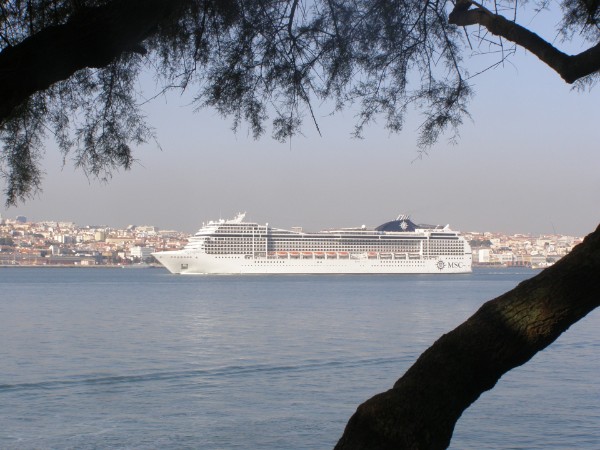
A ship that has sailed for MSC is alaso placed elsewhere on Castles Of The Seas
Rhapsody (1977-1994) is placed under Cunard Line
For booking information, visit the website of MSC Cruises.

